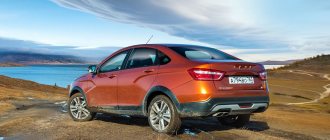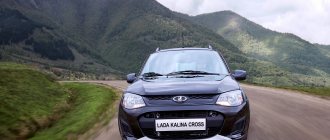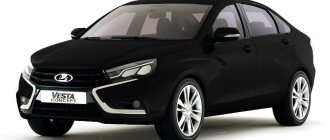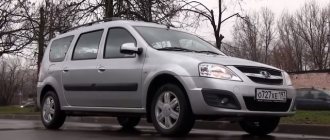The Lada Vesta SV Cross is equipped with a manual gearbox and an automated manual transmission. When purchasing a vehicle, the driver can choose the most preferable option. According to reports from AvtoVAZ, the company has launched a new project involving the production of the Lada Vesta Cross with a CVT.
Automatic transmission
What is AMT (robot)?
A robotic gearbox is essentially a typical manual transmission with an automated clutch. The AMT version is equipped with a special control unit and gear shift and clutch release mechanisms. If a standard automatic transmission transmits torque from the engine to the wheels via a torque converter, then an AMT transmits it using a set of gears.
In 2015, a serial robotic gearbox appeared for the first time for production models of a domestic manufacturer. Work on the project was led by Vladimir Petunin (project manager and initiator of its launch). There were already a lot of rumors about VAZ’s own AMT at that time (among car enthusiasts, mainly on social networks). A typical 5-speed manual transmission was used as a base. The final version of the automated gearbox received the VAZ 2182 index.
Many contradictions arise when operating the Vesta Cross robotic transmission, this is confirmed by professional tests and reviews from car enthusiasts. Below we note the main advantages and disadvantages of a car with this unit.
Advantages
- Reliability of the design (after all, they took a reliable time-tested mechanical transmission as a basis);
- Fuel economy (test results from major automotive communities confirm a reduction in fuel consumption of up to 30%, compared to similar models without a robotic transmission);
- Ease of repair (among the most common breakdowns, it’s all about using base components (manual transmission 2180));
- Increased clutch life by 35-40 percent (which increases economy and driving safety in general).
Flaws
- Reduced gear shift speed and “jerky” shifts (the problem is hidden in the cheapness of the design);
- The impossibility of constantly using the auto mode in the city (the working life is significantly reduced, you have to use the manual mode);
- Lack of ability to reprogram the unit (control unit in particular). This prevents all attempts by car owners to “customize” the operation of the box to suit themselves. However, this drawback is easily mitigated by the expiration of the warranty period (the firmware is simply changed);
- Frequent “opening” of the clutch, due to overheating, when climbing a slope (therefore, “uphill” it is better to use manual mode).
Technical characteristics of Vesta Cross with robot
| name of the characteristic | indication |
| Engine capacity, cubic meters cm | 1774 |
| Power, hp / kW | 122 / 90 |
| Torque, nm | 170 |
| Max. speed, km/h | 181 |
| Acceleration to 100 km/h, bitches | 13,3 |
| Fuel consumption, l | |
| In the city | 10.1 |
| Along the highway | 6.3 |
| Mixed | 7.7 |
The transmission control unit algorithm is configured here to minimize any jerks while the car is moving. True, the mechanism is not perfectly tuned, and therefore you will still have to control the gas pedal more smoothly. This is why the gear shift slows down - the transition from 1st to 2nd lasts 1.7 seconds, as a result of which there is a decrease in acceleration. The first gear in the AMT Vesta Cross is very short, but the second gear is stretched. From 2nd to 3rd gear the hesitation becomes less, and then the shifts go like clockwork. Try to avoid sudden actions with the gas pedal - otherwise jerks cannot be avoided.
The forced smooth ride partly contributes to fuel economy - but only partly. The main reasons for the reduced consumption lie elsewhere:
- The gear ratio of the main pair is reduced to 3.9, which significantly reduces engine speed and reduces fuel consumption;
- Very smooth gear shift adjustment. It is worth mentioning here that a typical VAZ gearbox, in comparison, will work much faster.
Video of Lada Vesta acceleration with 1.8 engine and robot
This is a video of the acceleration of a car in a sedan body; the acceleration of the cross version will be a little slower due to the increased weight and larger diameter wheels.
Cost of a car with AMT
As already mentioned, only cars with an engine capacity of 1.8 liters and a power of 122 horsepower are equipped with such a gearbox. The cost of the robot is 25 thousand rubles. In principle, in our time this is not such a large amount. Moreover, you will save on gasoline, oil and maintenance. Thus, this option is very profitable in terms of finances.
Below is a detailed story about the Lada Vesta SV Cross with a robotic gearbox:
Owner reviews about Vesta Cross with AMT
“I was able to try out the new Lada Vesta literally a few days after the official presentation: fortunately, a friend working in the salon helped. In terms of handling, the car behaves like a regular sedan, I didn’t notice any special dynamics, apparently, it was cut off by the AMT gearbox. I can say the following about the box itself: if you don’t pull the gas pedal, the robot does its job very well. I would like to try the version of the car with a turbocharged engine.”
(Evgeniy, Moscow)
“Initial reviews of the new Lada Vesta Cross model excited me and aroused very strong interest. I immediately signed up for a test drive, which I was very lucky with - it was a day off and the roads were clear. Having accelerated to 90 km/h, I noticed the first drawback: the noise insulation leaves much to be desired; if you exceed the barrier of 90, you can feel like a pilot of a Soviet transport aircraft - the hum is like during takeoff.
The handbrake position is not very convenient, it is placed almost close to the armrest, it is very inconvenient to use - I don’t understand how the inspection commission missed it. However, I got a car literally 3 months after the test drive. Already during operation, I noticed jerks when driving around the city, but this is more likely due to my driving style.”
(Alexander, Vladimir)
“I am the owner of Vesta Cross with an AMT robot. I'll start with what I liked most:
- quality of plastic in the cabin;
- appearance of the car;
- body kits are installed perfectly - no cracks or gaps;
- functional adjustment of the steering wheel and seats.
Of the minuses, I can note the following:
- small trunk capacity, you often have to fold the rear seats;
- There are problems with the spaciousness of the interior; with average dimensions and a height of 185 cm, I felt a little cramped at first.
Otherwise, the car performed excellently, both in the city and on numerous trips out of town.”
(Kirill, Nizhnekamsk)
“I bought the Cross version to replace the previous version (from 1.6). I didn’t notice any particular differences in the comfort and general parameters of the car, but the driving style had to be slightly adjusted. I was again pleased with the reduced consumption; I still haven’t found an answer to the question of what is the secret of such a difference. Unfortunately, the oil intake has not really disappeared, except that according to my own observations, it has become significantly less wasted. I’m very pleased with the car, and I feel that it will be difficult to switch to something else now.”
(Vsevolod, Yekaterinburg)
Review from the owner of Lada Vesta “Comfort” GFL12-51-070, 1.6 AMT engine
I left the salon. The robot manically switches up at the first opportunity, 60 on the fifth. Shifts are smooth, soft, no jerks or kicks. The pedal is long, on the Prior you have to press it a couple of centimeters and you fly, here you have to push far to keep it going.
You roll in auto mode on his favorite 1500, press the pedal, the robot is like - what? drive? where to go? A! he pressed the pedal! okay, okay, let's go, so be it. Drops a gear or two down, then normal acceleration with a sound familiar to the ear. It shifts exactly as you press. You stroke the pedal and the gears quickly click up. If you press harder, it turns up to 2000-2500. You press half the pedal - 3500 and you feel the usual pickup, there is no rush to switch. I didn’t press further for now.
The robot has a manual (manual) mode, it works something like this - Allows you to switch the way you want. Anywhere, anytime. What the robot does itself in this mode: in the cut-off it clicks up, when braking down, 5-4-3-2-1. Except for 1st gear, it does not shift up at any speed - in order to slip, drag trailers uphill, and so on. In manual mode, shifting is slightly faster. No worse, no better - for different tasks. You have to make some misbehavior - push the stick to M, push yourself twice, gas and off you go. I calmed down - put the handle in A and leaned back on the seat.
I used to say that the AMT switches like I do on a manual. No, it's not like that. She switches better than me. Smoother, faster, more accurate. Starts off instantly. A person can't do that. And if you let off the gas a little when switching, you don’t feel it at all, absolutely. In terms of switching time, AMT is at least the same as a simple automatic transmission, and maybe faster. The difference is that the automatic transmission shifts without a break in power, compressing one package and releasing the other, while the AMT needs to disengage the clutch, and you can feel it. The switching moment is comparable to a gust of wind on the highway. When you switch the manual transmission yourself, at that moment you are busy squeezing the clutch and shifting, but with AMT you are not doing anything, so the pause attracts attention. If you sit down like a sheep and press the gas to the floor, yes, it will make you nod, because the gear shift still remains smooth, no matter how much you press the pedal. In general, I think you can make the robot simply release the clutch during sharp acceleration, then you won’t have to nod, but there will be jerks. This should all be simple and understandable to those who drive a manual transmission. Fuel consumption on AMT is even lower than on manual transmission. In general, AMT is great. Especially considering the price tags for repairs and maintenance compared to a CVT or automatic transmission.
Brief impressions of the car.
Surprisingly, the Shumka is really not bad. Even the roof is noisy, the rain does not drum. I can't hear the engine. You can hear a certain hum from the wheels, not road noise, but just a hum. The murmur, like an open window, is very quiet. The doors close with a nice, quiet slam, as does the trunk. Perhaps I’ll add vibrations to the doors and leave it at that.
The chassis is still stiff after the Priora. Small irregularities are not felt, but the car follows the profile of the road exactly. But the energy intensity of the suspension is like that of a rally car. I don't know what needs to be done to break through it. More travel means fewer holes.
It stays straight like a tram. The wind, the potholes, the ruts - absolutely no problem. The steering wheel doesn't even move. The steering wheel is tight, of medium sharpness, with noticeable effort. It takes turns confidently, without rolls or drifts. Checkers - lightly, slightly moving the steering wheel.
The brakes are ideal in terms of pedal force and deceleration control. ABS and stabilization did not work, it was dry outside. The speed is felt weakly. You seem to be going about 60, you glance at the speedometer - it’s 100+. In general, it is very simple and easy to drive.
It's comfortable behind the wheel. The seat is not sporty, it is moderately soft, there is height adjustment and lumbar support. The steering wheel is adjustable for reach and height. The armrest in the middle is exactly as it should be. The interior is large, larger than in many C-class cars. Five of us will be comfortable.
The climate system is excellent. The air pressure is strong, the adjustment is smooth, the choice of modes is electronic, the air conditioning is not felt at all while driving.
The plastic in the cabin is very different. The steering wheel is soft and has different textures. The gear knob is normal. The panel and door trims are solid, just like the Polo. So far there is absolutely nothing squeaking. The trunk is lined with soft fleecy carpet.
The light is excellent. There is nothing more to say. I will add PTF. There are two LED lampshades in the cabin, the light is of medium brightness and diffused, but each works independently. You cannot turn on all the lights with one button.
There are not enough drawers and shelves. There is only a huge glove compartment, a small shelf and two cup holders on the beard and a small drawer in the armrest. And the door handles are made like a mini shelf for small items. All. But the pockets in the front doors are a glove keeper's dream, they are gigantic. There are no pockets at the back.
The music is the most ordinary. The staff is just a staff, nothing special, like everyone else. Radio, USB flash drive, SD flash drive, bluetooth, AUX. Large buttons, control from the steering wheel. Out of habit, I point at the phone and forget about the steering wheel. There is an ACC mode.
Disadvantages - unpleasant ESP buttons, tight and with a short stroke, like on a grant. The climate control knobs rotate without effort and have some play. The visors, when folded toward the glass, dangle on the bumps. Dim light in the trunk.
A bit of new impressions. The Vesta suspension was fine-tuned in Spain at the training ground. So, on roads close to those in Spain, the car drives wonderfully. But as soon as you drive off the road onto broken asphalt, or onto a road with artificial bumps, it starts to shake violently. The suspension regularly follows the profile of the road. Now I’m ready to kill for sun loungers. Yes, even when driving on normal roads of varying quality, you feel the difference very clearly. And this is on small 15 wheels with a high profile. Priora didn’t give a damn that there was soil, asphalt, crushed stone, milling cutter under the wheels, as long as all the irregularities were within 18 cm of clearance, always soft and comfortable. This is the price of good handling
Vesta is a good car, I can say that now for sure. Good quality, comfortable, beautiful and big. It’s not ideal, but it evokes positive emotions and makes me want to drive it.
Yesterday I went for a free inspection to the dealer. Before this, I returned the standard mafon back just in case. They examined it, extended it, everything was as it should be, they said that everything was fire. Only the front wheels and a couple of nuts on the front were stretched. We were allowed into the repair zone without any problems. The removed caps were pulled back with zip ties - that’s nice. The mileage is now about 1600 km, the average consumption according to the BC is 9.3 liters.
I noticed that there are no caps on the front hubs, it needs to be farmed. The most vulnerable point on the body is the rear tow hook, it’s at the very bottom of the rear overhang, I’ve already gotten caught somewhere. Additional protection without holes at all. But the face turns out to be completely smooth, from the front bumper to the floor, which is good for winter.
I really like the car. There are a couple of points on Shumka that I will do, but these are minor things. Parking sensors are a thing for the lazy, but very convenient. I use cruise even in the city sometimes, at 77 km/h. The light is excellent. The A-pillars are wide, the hood is high, and sometimes I look for curbs in yards through the side windows. The glazing has an interesting effect - it is positioned at such an angle that from the outside it seems as if it has been tinted with thirty, there is no feeling of an aquarium. I washed the interior - the plastic is somehow slippery, the dirt is wiped off very easily in one motion without streaks. The seats are a strong magnet for hair and cat fur.
And the motor opened. After 3000 it drags the 1.3-ton car very cheerfully with a characteristic rumbling sound. Not the same as on the Prior, there it was less pronounced and with some kind of whistling. Although the 129 is more powerful from the bottom than the simple 126, its combat character remains the same. This makes me happy.
The variable intake switch is audible in the cabin and works a little differently than I thought it would. It is triggered not by revolutions, like phasers, but by the load on the motor. If you drive calmly, it is closed even at 4000. As soon as you press the pedal, a growl appears from under the hood, while traction improves. At 1500 it is even very loud, at 3000 it merges with the engine. In hot weather with Conder, the damper opens almost every acceleration.
AMT, in principle, has already adapted to my driving style and almost always switches on time. But it was not possible to discourage his manner of switching up at the first opportunity to save money. A couple of times there was a freezing of 1st gear during repeated sharp stomping from a standstill half a meter and braking in the city crowd. It has a mode for hauling trailers and climbing uphill, when under load it holds first gear and does not shift, apparently it thought that I was accelerating somewhere off-road. It can be treated by switching to M and back to A. It also coolly re-throttles itself, switching down when pressing hard on the gas.
Price
The cheapest version of Vesta SW Cross with 1.8, equipped with a robot (AMT), is the Luxe package. This option will cost no less than 821,000 rubles. This is a car equipped with all the necessary functions, with an acceptable level of safety and comfort.
The next step can be called Luxe Multimedia (849,000 rubles). The difference with the previous version is that this one is equipped with a built-in multimedia system with a navigator and 6 speakers (Luxe comes without multimedia and has 4 speakers on board). Otherwise, it is no different from the junior configuration.
For Vesta Cross in the Luxe Prestige configuration you will have to pay 867,000 rubles. In addition to the basic functionality, it also has increased tinting of the rear windows, and the rear seats are heated and have an armrest. You can get acquainted with a detailed description of all configurations and prices by following this link on our website.











